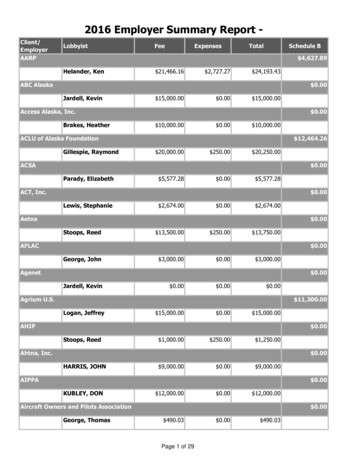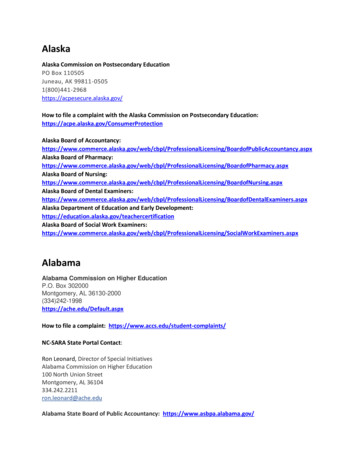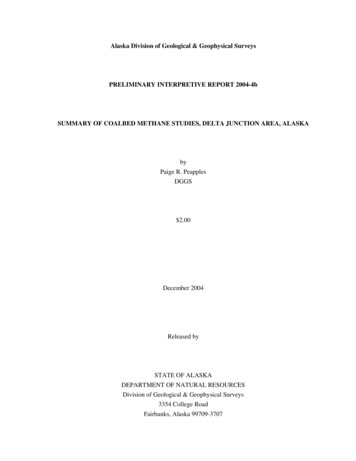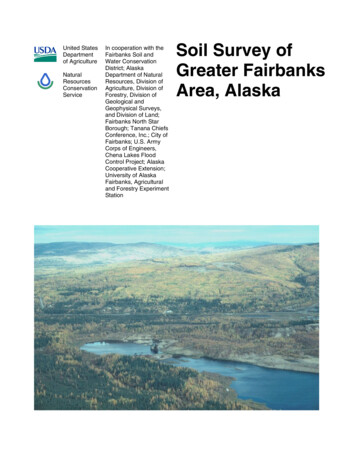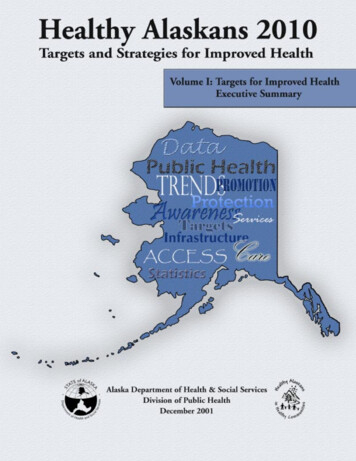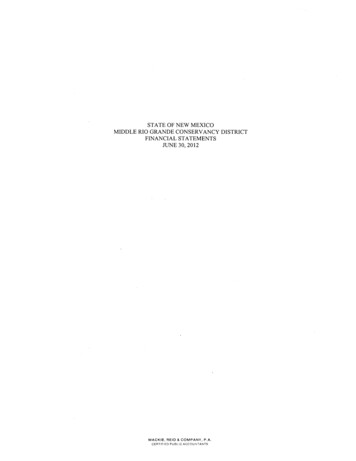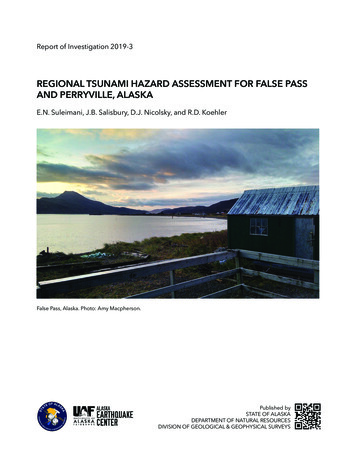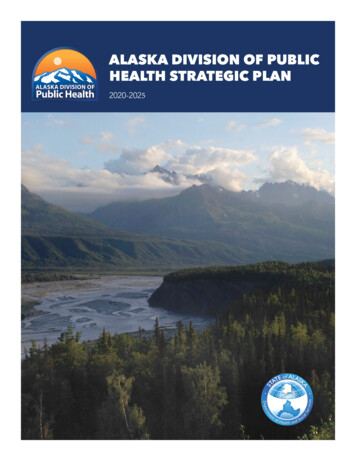
Transcription
ALASKA DIVISION OF PUBLICHEALTH STRATEGIC PLAN2020-2025
AcknowledgmentsThis five year Division of Public Health (DPH) Strategic Plan reflects the results of a collaborativeplanning process that included multiple Division employees. These efforts were built from afoundation of input given by Alaskans and partner organizations around the state who took the timeto respond to a DPH Strategic Plan survey and public comment period. Assuring that Alaskans havethe highest quality public health services and programs is truly a team effort; thank you to all who haveparticipated in this effort. This data informed document was written by the DPH Quality & PerformanceImprovement Manager in April 2020.DPH STRATEGIC PLAN WORKGROUPSean Armstrong, MPH, RN Section of Public Health NursingClint Farr, MS Section of Health Analytics & Vital RecordsJessica Harvill, MPH Section of EpidemiologyLisa McGuire, MPH Director’s OfficeBecky Morisse, RN, BSN, MPH Section of Women’s, Children’s, Family HealthAllison Natcher, MPH Section of Rural Community Health SystemsTari O’Conner, MSW Section of Chronic Disease Prevention and Health PromotionPeggy Sue Wright, RN, MSN, PHCNS-BC, DrPH Section of Public Health NursingDPH EXECUTIVE LEADERSHIP TEAMBritten Niemi Administrative Office ManagerLead: Administration & Management WorkgroupClint Farr, MS Section Chief, Section of Health Analytics & Vital RecordsLead: Data Informatics & Health Communications WorkgroupsHeidi Hedberg Division Director,Lead: Collaborative Partnerships WorkgroupBernie Jilly, PhD Section Chief, Public Health LaboratoriesSondra LeClair Section Chief, Section of Rural Community Health SystemsJill Lewis Division Deputy DirectorElizabeth Manning Department of Health & Social Services, Public Information OfficeLisa McGuire, MPH Quality & Performance Improvement Manager, Director’s OfficeLead: Quality & Performance Improvement WorkgroupJoe McLaughlin, MD, MPH Section Chief, Section of EpidemiologyBecky Morisse, RN, BSN, MPH Section Chief, Section of Women’s, Children’s, Family HealthLead: Workforce Development WorkgroupTari O’Conner, MSW Section Chief, Section of Chronic Disease Prevention and Health PromotionLead: Health Equity WorkgroupCristin Rolf, MD Chief Medical Examiner, State Medical Examiner’s OfficeTim Struna, RN, MPH Section Chief, Section of Public Health NursingTheresa Welton, BSW Section Chief, Office of Substance Misuse & Addiction PreventionAnne Zink, MD, FACEP Chief Medical Officer, Department of Health & Social Services02 A L A S K A D I V I S I O N O F P U B L I C H E A LT H S T R AT E G I C P L A N
Message from Division of Public Health DirectorIt is my pleasure to present to you the Alaska Division of Public Health’s threeyear strategic plan for 2020-2025. This plan establishes a strong unified vision forthe Division’s future and the shared work ahead. Like all that we do, this plan restson a solid foundation of data. The planning process began with input from divisionpersonnel, the public, and key partners about our past performance, emergingissues, and the significant challenges in improving population health that we faceas a state. Using this data, with the state health assessment and improvement plan,as well as our internal quality improvement plan, we agreed on our priority focusareas, goals, and objectives that will better position the division toward our vision of Healthy and resilientAlaskans today and tomorrow. The goals are organized within the core functions as a division which areas follows: serve as a strategist for existing and emerging public health issues; protect life, health andsafety of all Alaskans and prevent injury and chronic disease; serve as the trusted source of public healthinformation; and strengthen essential public health partnerships, services and infrastructure.In this plan you will notice a focus on health equity as a key principle in improvement of health outcomesin our state. You will also notice a focus on people and partnerships; our workforce, our partners andstakeholders, and the residents of Alaska. Alaska is unique in its vastness, geographic remoteness, andin its rich diversity of people who work together to make positive things happen. It truly is only togetherthat we can make the health outcomes and changes that we all desire. Lastly, you will notice a focus onperformance improvement; measuring progress, learning from our past efforts through evaluation, andusing evidence to make informed decisions about our future direction. This plan is part of an ongoingstrategic planning process and our goals, objectives and strategies will continue to evolve throughperiodic evaluation and adjustment. Every part of the division will be engaged in this work. Now morethan ever, it is abundantly clear to us all that public health is everyone’s responsibility. Let’s unite togetherfor a healthy and resilient Alaska!— Heidi Hedberg, DPH Director“The past gives us experience and memories;the present gives us challenges and opportunities;the future gives us vision and hope”— William Arthur WardA L A S K A D I V I S I O N O F P U B L I C H E A LT H S T R AT E G I C P L A N 03
Strategic Plan PurposeThis strategic plan sets forth what the Alaska Division of Public Health intends to achieve asan organization and how it will achieve it. The strategic plan provides a common foundation to setdirection, serves as a guide for making informed decisions and allocate resources, and commits thedivision to evaluating performance as it strives to meet the public health needs of Alaskans.The Division of Public Health conducted a strategic planning process during the fall of 2019 to define thedirection and course of the agency for the next three years. The plan positions the division to operateas an effective and significant part of the state’s overall public health system by providing Alaskans withquality public health services. This plan is a living document that the division will implement, monitor andevaluate regularly to address the public health needs of the state as human, financial, and leadershipcapacity allows.2020-2023 DIVISION OF PUBLIC HEALTH STRATEGIC PLAN PROCESSACTPLANDO04 A L A S K A D I V I S I O N O F P U B L I C H E A LT H S T R AT E G I C P L A N
Strategic Planning ProcessThe Division of Public Health Executive Leadership Team (ELT), composed of the Chief MedicalOfficer, Division Director, Deputy Director, Section Chiefs, Public Information Office and QualityImprovement staff, along with the Strategic Planning Workgroup, conducted a strategic planningprocess over the course of several months in 2019.Communitymembers andpartners: The firststep in the planningprocess was togather input fromexternal partners andDr. Jerome Adams, Surgeon General of the United States, visits the Alaska Division of Public Health.the public through astrengths,weaknesses, opportunities, threat (SWOT) survey and to review the input residents already offered thatwas summarized in the State Health Assessment and State Health Improvement Plan, Healthy Alaskans.Division Personnel: Staff internal to the division were also asked to identify the division’s strengths,weaknesses, opportunities, and threats and to give input regarding the division’s performance.Division Leadership: The themes that emerged through the SWOT analysis from staff, the public andpartners were reviewed and discussed by division leadership. The division’s Executive Leadership Teamalso reviewed the results of Alaska’s Public Health System Assessment, past performance of State HealthImprovement Plan leading health indicators and the division’s Quality Improvement plan.The following is a summary of identified themes from external partner and Division staff input that formedthe basis for the strategic plan and are reflected in the priorities, goals, and objectives within the plan.STRENGTHS Division of Public Health staff are professional, competent and dedicated, Use data and evidence to inform programs, strategies and services, Responsive to public health emergencies, outbreaks, emerging issues, Readily shares data, staff, expertise, and funding, Serve as a hub and resource for public health information, Consistent, strong community collaborative partnerships with other entities, and Excellent public health messaging, informing the public, and providing public health education.OPPORTUNITIES FOR IMPROVEMENT DPH is consistently underfunded and understaffed which results in limitations of services;not meeting the health needs of entire age ranges and populations, Need to strengthen communication about the importance of public health to increase awarenessand support, Must increase and improve health communication and availability of data using moderncommunication tools and methods,A L A S K A D I V I S I O N O F P U B L I C H E A LT H S T R AT E G I C P L A N 05
Must increase collaborative partnerships with other organizations and entities to increase localengagement and investment in public health, Need to remove internal administrative barriers to efficiency, Must consider shifting to a public health systems approach and focus on primary prevention(including Adverse Childhood Experiences, social determinants, strengths based, trauma informedpractices, and focus on the young), and Need to increase collaboration between DPH sections and use an overarching framework andalignment across sections and increase communication across sections.EXTERNAL TRENDS, FACTORS AND CONSIDERATIONS THAT MAY IMPACT THEDIVISION OF PUBLIC HEALTH Decreased funding of public health programs and services via budget cuts, Staff turnover, causing workforce instability and limited capacity, Lack of ongoing public education about the value of public health and public support, Vaccine hesitancy, The general devaluing of public health, Specific health threats (pandemic flu, substance misuse, re-emerging infectious diseases, anti-fluoride,natural disasters, basic prevention, senior health, unintended pregnancy prevention), Anti-science and distrust of government vocal portion of the public.All data were considered during two strategic planning sessions during which time the mission, vision,core functions, and overarching goals were agreed on. This summary information was sent to externalpartners and internal staff to get further input which was used to modify and strengthen the goals.Workgroups, each led by an ELT member, were formed to develop a work plan composed of objectives,strategies and measures for each goal. Implementation of these work plans began in January 2020and will continue throughout the three year strategic plan cycle until completed or modified as regularperformance reporting and evaluations are conducted. When developing objectives and strategies, theDivision had to keep in mind certain capacity considerations and limitations so that the plan would befeasible within a three year timeframe. These considerations include workforce stability and capacity,limited financial resources, existing infrastructure and technology systems issues, communicationsmanagement, and support from State leadership.“The significant problems we face cannot be solved at thesame level of thinking we were when we created them”— Albert Einstein06 A L A S K A D I V I S I O N O F P U B L I C H E A LT H S T R AT E G I C P L A N
Division of Public Health OverviewThe Alaska Division of Public Health is one of the largest operating divisions within theDepartment of Health and Social Services in Alaska state government. As the primary public healthpresence in many communities, the division assures access to quality care and promotes the health ofall people in the state with a focus on preventive measures. The Division of Public Health is a significantentity within in the overall statewide health system which includes tribal, local, and regional public healthproviders.DPH employees and staff are well known throughout the state. While the Division’s base operations arefound in Alaska’s larger communities, Public Health Nurses and other division staff are on the front lines intowns and villages everywhere.The division coordinates access to federal initiatives, provides training and certification, technicalassistance and oversight, and specialty public health services. It is a source of up to date healthinformation and analytics for the governor, local governments, and Alaskans. This information is usedto monitor the health status of Alaska’s residents, set health priorities and evaluate the effectivenessof health initiatives. Regulatory functions are focused on positive health outcome and assuring qualityand safety, while also minimizing the administrative burden on the personnel, facilitates and programsregulated.The Division of Public Health currently has approximately 425 staff positions located in 23 communitiesorganized into ten sections; each tasked with providing services to help the agency achieve its vision ofHealthy and resilient Alaskans today and tomorrow.The Alaska Division of Public Health administers a budget in fiscal year 2020 comprised of approximately 116.7 million dollars. Forty-one percent is received through federal grants, 36 percent is fromundesignated state general funds, 15 percent from designated general funds, and 8 percent is fromother sources.funds 47,565,800.041%Other funds 8,960,200.08%Undeslgnatedgeneral funds 42,231,000.036%Designatedgeneral funds 17,992,900.015%A L A S K A D I V I S I O N O F P U B L I C H E A LT H S T R AT E G I C P L A N 07
DIVISION OF PUBLIC HEALTH SECTIONSThe Division of Public Health is a highly complex agency comprised of ten distinctly diversesections. The ten sections of the division represent the work being done within the PublicHealth Core functions, foundational and 10 essential services as well as work to addressAlaska’s most significant health needs.usDeathsAK Age Ad1usted RateUS Age Ad1usted RateRank1. Cancer934173.8168.622. He art Disease737148.8173.713. Unintentional Injuries377S6.038.0s4. Chronic Lower Respiratory Dis.19341.242.735. Stroke16738.937.946. Suicide14220.012.0107. Diabetes10620.221.5712of Death8. Chronic Liver Dis. and Cirrhosis9812.99.79. Alzheimer's Disease7220.424.6610. Influenza and Pneumonia5959598Source:ABVS; NCHS (2011 Preliminary)Section of Chronic Disease Prevention & Health Promotion (CDPHP) works with communities,health systems, worksites, and schools to reduce and manage the most prevalent, costly, andpreventable health problems across Alaska. This section promotes behaviors that prevent injuriesand reduce the prevalence of chronic diseases such as diabetes, obesity, and heart disease byencouraging healthy, active, and safe lifestyles, collecting and sharing scientific data; supportingevidence-based practices in communities and promoting community conditions that result inhealth equity.Section of Health Analytics and Vital Records (HAVRS) is responsible for administering vitalrecords for events that occurred within the State of Alaska. Vital records include data from births,deaths, divorces, and marriages, as well as reports of adoption, paternity, and amendments. Thissection also collects inpatient and outpatient discharge data from Alaska health care facilities,issues burial transit permits, oversees the medical marijuana registry and analyzes data andprovides reports to help guide policy.Office of Substance Misuse & Addiction Prevention (OSMAP) uses a public health approachto prevent and reduce substance use disorders, prevent harm caused by substance use andsupports community-based activities across Alaska. OSMAP activities are focused on opioid andmarijuana misuse and addiction prevention, data and evaluation, including program and systemschanges to mitigate harm.Section of Rural Community Health Systems (RCHS) leads the way in preparing the Stateof Alaska and its citizens for any public health emergency or disaster, either natural or humancaused. This section is responsible for providing educational materials to healthcare agenciesand the public, training first responders and healthcare agencies, conducting readiness exercisesfor and with local, state, federal, tribal partners, and providing grant funding for hospital andhealthcare preparedness and Emergency Management Services (EMS) operations.08 A L A S K A D I V I S I O N O F P U B L I C H E A LT H S T R AT E G I C P L A N
DIVISION OF PUBLIC HEALTH SECTIONSSection of Public Health Nursing (SOPHN) operates 16 public health centers throughoutAlaska and serves 280 small communities and villages. This section offers services such asimmunizations, family planning, prenatal counseling and postpartum outreach, well child exams,tuberculosis screening and treatment, school screenings, sexually transmitted infection screening.Public health nurses provide health promotion, protection and disease prevention activities toimprove the health of individuals, families, and their communities. Public health nurses emphasizecommunity and population health systems change – a role uniquely the responsibility of publichealth. Public health nurses prepare communities to respond to disease outbreaks, naturaldisasters, and other health hazards; and mobilize community partnerships to assess, develop andimplement improvement plans to create healthy environments and resilient communities.Section of Epidemiology (Epi) keeps Alaskans safe from communicable diseases, injuries andenvironmental, occupational, and other health hazards. This section collects data to assessinfectious disease and associated risk factors, identifies and responds to emerging infections,and conducts outbreak investigations and surveillance. Additionally, this section is tasked withevaluating the potential human health effects of new policies, programs, or development projectsin Alaska.Section of Women’s, Children’s and Family Health (WCFH) promotes optimum healthoutcomes for all Alaskan women, children, teens and their families through coordination with theprimary and public entities within the health care system to improve access to and organization ofservices in support of families. This section has a particular focus on children with special healthconditions, those with low income status and those with limited access to health services.Programs include breast and cervical cancer screening, family planning, coordinating pediatricspecialty clinics, newborn screening, prevention of and screening for substance use duringpregnancy, oral health, infant safe sleep, home visiting, school nursing, and adolescent health.State Medical Examiner’s Office (SME) is responsible for conducting medical and legalinvestigative work related to unanticipated, sudden, or violent deaths by conducting autopsies,providing court testimony and assisting with the review of all child deaths through the ChildFatality Review Team.Alaska State Public Health Laboratories (Labs) provides analytical and technical laboratoryinformation in support of state and national public health disease prevention programs andrepresents a first line of defense in the rapid recognition of the spread of communicable diseases.Laboratory tests are conducted to identify, treat, and control communicable diseases, and toprevent the ill-effects of toxic substances and radiation.Director’s Office (DO) ensures an efficient and effective division. This section providesmanagement and leadership, legislative and regulatory information, overall strategic directionand policy for the division, coordinates budget development, revenue and financial management,human resources services, procurement, and manages grants and contracts. This section is alsoresponsible for all division wide performance and quality improvement including public healthaccreditation activities.A L A S K A D I V I S I O N O F P U B L I C H E A LT H S T R AT E G I C P L A N 09
Division of Public Health Strategic Plan 2020-2025VISION:Healthy and resilient Alaskans today and tomorrow.GUIDING PRINCIPLES:Service, Health Equity, Integrity, Excellence, Leadership, and Dedication.MISSION:To promote the health of Alaskans. This is derived fromArticle VII of the Alaska Constitution which states “the legislatureshall provide for the promotion and protection of public health”and Alaska Statute AS 18.05.010(a) Section 18.05.010Administration of laws by department.CORE FUNCTIONSServe as astrategist forexisting andemerging publichealth issues.Protect life,health andsafety of allAlaskans andprevent injuryand chronicdisease.Serve as thetrusted sourceof public healthinformation.Strengthenessentialpublic healthpartnerships,services, andinfrastructure.GOALS1 — Addressrisk factors andconditions thataffect multipleaspect of healthand well-being.4 — Use qualityimprovementand performancemanagement toimproveprocesses andresults.10 2 — Increaseavailability ofreliable, trustedpublic healthdata to improvethe health ofAlaskans.5 — Strengthencollaborativepartnerships toachieve sharedhealth outcomes.A L A S K A D I V I S I O N O F P U B L I C H E A LT H S T R AT E G I C P L A N3 — Alignpublic healthinformationin ways thatare useful,understandableand actionable.6 — Enhancethe competencylevel andprofessionaldevelopment ofour workforce.7 — Providemanagementand leadershipto ensure anefficient andeffective publichealth system.
OUR GUIDING PRINCIPLESform a framework within which we conduct our work as public health professionals. Theseprinciples spell out the word “SHIELD” because the concept and act of prevention is whatsets the Division of Public Health apart from all others.SERVICE – Demonstrate commitment to public health throughcompassionate action and stewardship of time, resources and talentHEALTH EQUITY – Ensure that all Alaskans have full and equal access toopportunities to lead healthy livesINTEGRITY – Exemplify uncompromising ethical conduct and the higheststandards of responsibility and accountabilityEXCELLENCE – Use the best available knowledge, expertise, and data toinform public health polices and practiceLEADERSHIP – Provide public health vision, purpose, and strategies toimprove the health of AlaskansDEDICATION – Continuously and enthusiastically work to achieve the besthealth for Alaskans and their communitiesTHE CORE FUNCTIONS OF THE DIVISION OF PUBLIC HEALTH ARE: Serve as a strategist for existing and emerging public health issues Protect life, health and safety of all Alaskans and prevent injury and chronic disease Serve as the trusted source of public health information Strengthen essential public health partnerships, services, and infrastructureA L A S K A D I V I S I O N O F P U B L I C H E A LT H S T R AT E G I C P L A N 11
Strategic Goals and ObjectivesThe three year strategic plan addresses the health needs of Alaskans identified in the State HealthAssessment, as well as areas of needed improvement from the most recent State Public HealthSystem assessment.The Division of Public Health continues to forge ahead in carrying out its critical responsibilities inchallenging times. Working together with federal health agencies, local communities and tribal healthorganizations, we are making a difference in the lives of all Alaskans.A number of plans, including the State Health Improvement Plan Healthy Alaskans, the 2016-2020 Divisionof Public Health strategic plan, the Quality Improvement Plan, and input given by staff and partners wereused to set priority focus areas, goals and objectives. The 2020-2023 Division of Public Health StrategicPlan goals are as follows:GOAL 1: Improve Alaska’s health by enhancing our ability to address risk factors andconditions that affect multiple aspects of health and well-being.Objective 1.1: Develop and present to department leadership a brief on Social Determinants ofHealth (SDOH) and recommended high priority SOA strategies.Objective 1.2: Ensure that high priority SDOH data is available in a public-facing online tool.Objective 1.3: Develop and begin implementation of a plan to support a workforce able toimplement SDOH interventions.Objective 1.4: Develop policies and guidance that create dedicated staff and funding toimplement high priority strategies to address and define clear linkages between SDOH andhealth outcomes in Alaska communities.Objective 1.5: Coordinate relationships with partners necessary to implement high prioritystrategies that address and provide clear linkages between SDOH and health outcomes inAlaskan communities.GOAL 2: Increase availability of reliable, trusted public health data to improve the healthof Alaskans.Objective 2.1: Ensure comprehensive documentation of data standards within the Division ofPublic Health.Objective 2.2: Implement data integration efforts within the Division of Public Health tooptimize data utility.12 A L A S K A D I V I S I O N O F P U B L I C H E A LT H S T R AT E G I C P L A N
GOAL 3: Align public health information in ways that are useful, understandable andactionable.Objective 3.1: Establish user friendly web-based platform for the communication and query ofde-identified Public Health Data.Objective 3.2: Develop an online Division of Public Health information clearinghouse.Objective 3.3: Develop and implement health communication training for program staff.Objective 3.4: Develop a division wide organizational branding strategy.GOAL 4: Use quality improvement and performance management to improve processesand results.Objective 4.1: Attain accreditation status with the national Public Health Accreditation Board(PHAB) to strengthen the Division’s ability to better serve Alaskans.Objective 4.2: Develop and implement a Quality Improvement Plan to improve the quality ofthe Division’s processes, services and programs.Objective 4.3: Develop and implement a system to evaluate and manage overall performanceof the Division and educate staff on how to use it.GOAL 5: Strengthen collaborative partnerships to achieve shared health outcomes.Objective 5.1: Improve the Division of Public Health’s ability to build and maintain successfulpartnerships.Objective 5.2: Identify and evaluate the benefits of established partnerships.Objective 5.3: Build new partnerships that maximize the use of available resources, includingpersonnel, subject matter expertise, and funding.A L A S K A D I V I S I O N O F P U B L I C H E A LT H S T R AT E G I C P L A N 13
GOAL 6: Enhance the competency level and professional development of our workforce.Objective 6.1: Decrease the overall Division vacancy rate of active positions by enhancing theDivision’s employee recruitment and orientation efforts.Objective 6.2: Decrease the Division turnover rate by enhancing employee retention efforts.Objective 6.3: Develop and begin to implement a written Division of Public Health WorkforceDevelopment Plan.GOAL 7: Provide management and leadership to ensure an efficient and effective publichealth system.Objective 7.1: Improve division administrative process efficiency.Objective 7.2: Develop policies and enforce laws that support division efforts to provide theessential services that protect and promote the public’s health.Objective 7.3: Enhance overall effectiveness of division management, leadership, and strategicoversight processes and actions.Objective 7.4: Secure stable and adequate funding to support foundational public healthservices and capabilities.“There are risks and costs to a program ofaction, but they are far less than the longrange risks and costs of comfortable inaction”— John F. Kennedy14 A L A S K A D I V I S I O N O F P U B L I C H E A LT H S T R AT E G I C P L A N
Next Steps: Implementation,Performance Monitoring & EvaluationStrategic planning is a key component of a larger performance management system. The Divisionof Public Health’s performance management system has four components; performance standards,performance measures, reporting of progress, and quality improvement. Through continuous integrationof all of these components, the division supports its capacity to improve the public’s health.PUBLIC HEALTH PERFORMANCE MANAGEMENT SYSTEMThe Division of Public Health Executive Leadership Team (ELT) formed a workgroup for each strategicplan goal, led by an ELT member. Work groups developed goal-specific work plans containingstrategies, measures and timelines, and are responsible for implementing and completing the work plan.They will also be responsible for tracking specific indicators and reporting progress periodically. TheExecutive Leadership Team is responsible for monitoring and guiding progress of overall strategic planimplementation with the use of a performance measure tracking system.As the Division of Public Health moves ahead in the years to come, it will do so with an overarchingcommitment to build a healthier Alaska, despite the numerous challenges faced including decliningresources and emergent public health threats. This strategic plan is a roadmap that lays the managementfoundation for change and improvement within the Division of Public Health. The dedicated employeesof the Division of Public Health bring a wealth of expertise and a commitment to improving the wellbeing of the people of Alaska. Our partners in the public health system are equally committed to creatinga healthier Alaska, which is why we incorporated their input into the development of this plan. Together,we will achieve our vision of healthy and resilient Alaskans today and tomorrow.A L A S K A D I V I S I O N O F P U B L I C H E A LT H S T R AT E G I C P L A N 15
“Progress is impossible without change, and those whocannot change their minds cannot change anything”— George Bernard ShawAlaska Division of Public Health, Director’s OfficeVersion 1.0 (New) June 2020For more information, please contacthss.publichealth@alaska.gov or(907) 465-3090 or visit http://dhss.alaska.gov/dph
quality public health services. This plan is a living document that the division will implement, monitor and . evaluate regularly to address the public health needs of the state as human, financial, and leadership . capacity allows. 2020-2023 DIVISION OF PUBLIC HEALTH STRATEGIC PLAN PROCESS . 04 ALASKA DIVISION OF PUBLIC HEALTH STRATEGIC PLAN

